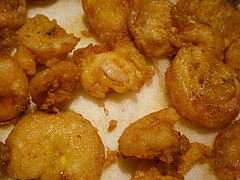
Tempura is a typical Japanese dish that usually consists of seafood and vegetables that have been coated in a thin batter and deep fried. Tempura has its origins dating back to the 16th century, when Portuguese Jesuits brought the Western-style cooking method of coating foods with flour and frying, via Nanban trade.
Sweet and sour is a generic term that encompasses many styles of sauce, cuisine, and cooking methods. It is commonly used in East Asia and Southeast Asia and has been used in England since the Middle Ages. Sweet and sour sauce remains popular in Asian and Western cuisines.

Macaroni salad is a type of pasta salad, served cold, made with cooked elbow macaroni and usually prepared with mayonnaise. Much like potato salad or coleslaw in its use, it is often served as a side dish to barbecue, fried chicken, or other picnic style dishes. Like any dish, national and regional variations abound but generally it is prepared with raw diced onions, dill or sweet pickles and celery and seasoned with salt and pepper.

Filipino cuisine is composed of the cuisines of more than a hundred distinct ethnolinguistic groups found throughout the Philippine archipelago. A majority of mainstream Filipino dishes that comprise Filipino cuisine are from the food traditions of various ethnolinguistic groups and tribes of the archipelago, including the Ilocano, Pangasinan, Kapampangan, Tagalog, Bicolano, Visayan, Chavacano, and Maranao ethnolinguistic groups. The dishes associated with these groups evolved over the centuries from a largely indigenous base shared with maritime Southeast Asia with varied influences from Chinese, Spanish, and American cuisines, in line with the major waves of influence that had enriched the cultures of the archipelago, and adapted using indigenous ingredients to meet local preferences.

Bistek, also known as bistek tagalog or karne frita, is a Filipino dish consisting of thinly-sliced beefsteak braised in soy sauce, calamansi juice, garlic, ground black pepper, and onions cut into rings. It is a common staple in the Tagalog and Western Visayan regions of the Philippines. It is eaten over white rice.

The generic term for condiments in the Filipino cuisine is sawsawan. Unlike sauces in other Southeast Asian regions, most sawsawan are not prepared beforehand, but are assembled on the table according to the preferences of the diner.

Shrimp or prawn dishes are often prepared by frying, especially deep frying. There are several styles.

Peanut sauce, satay sauce, bumbu kacang, sambal kacang, or pecel is an Indonesian sauce made from ground roasted or fried peanuts, widely used in Indonesian cuisine and many other dishes throughout the world.
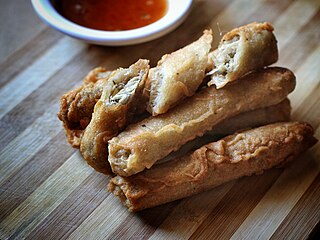
Ngohiong, also known and pronounced as ngoyong, is a Filipino appetizer consisting of julienned or cubed vegetables with ground meat or shrimp seasoned with five-spice powder in a thin egg crêpe that is deep-fried. It is a type of lumpia and is a Filipino adaptation of the Hokkien dish ngo hiang. It originates from Cebu City.

Chahan, also known as Yakimeshi, is a Japanese fried rice dish prepared with rice as a primary ingredient and myriad additional ingredients and seasonings. The dish is typically fried, and can be cooked in a wok. Chahan may have originated in the 1860s from Chinese immigrants arriving at the port of Kobe. Chahan is a staple food in homes in Japan. Some restaurants outside Japan serve the dish as a part of their fare.
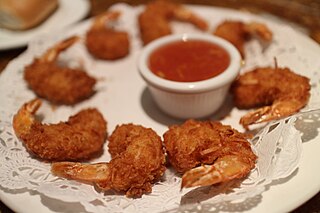
Coconut shrimp is a shrimp dish prepared using shrimp and coconut as primary ingredients. It can be prepared as a crunchy dish with the shrimp coated and deep fried, pan-fried or baked, and as a sautéed dish using coconut milk and other ingredients. It can be prepared and served on skewers.
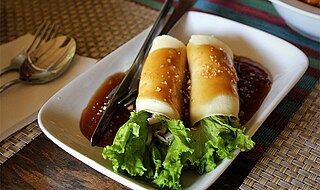
Lumpiang ubod, also known as heart of palm spring rolls, is a Filipino appetizer consisting of julienned ubod with various meat and vegetables in a thin egg crêpe. It is commonly served fresh, but it can also be deep-fried. It originates from the city of Silay in Negros Occidental where an original variant, lumpiang Silay, is still popular.

Tortang talong, also known as eggplant omelette, is an omelette or fritter from Filipino cuisine made by pan-frying grilled whole eggplants dipped in an egg mixture. It is a popular breakfast and lunch meal in the Philippines. A common variant of tortang talong is rellenong talong, which is stuffed with meat, seafood, and/or vegetables.

Morcón or morconito, is a Philippine braised beef roulade made with beef flank steak stuffed with hard-boiled eggs, carrots, pickled cucumber, cheese, and various sausages. It is commonly served during Christmas and other festive occasions.

Pininyahang manok, commonly anglicized as pineapple chicken, is a Philippine dish consisting of chicken braised in a milk or coconut milk-based sauce with pineapples, carrots, potatoes, and bell peppers. Some variants of the dish use a chicken stock base instead of milk. The dish originates from Southern Luzon which was once a regional center of pineapple fiber production in the Spanish Philippines.

Okoy or ukoy, are Filipino crispy deep-fried fritters made with glutinous rice batter, unshelled small shrimp, and various vegetables, including calabaza, sweet potato, cassava, mung bean sprouts, scallions and julienned carrots, onions, and green papaya. They are traditionally served with vinegar-based dipping sauces. They are eaten on their own or with white rice. They are popular for breakfast, snacks, or appetizers. Okoy are sometimes dyed bright orange with achuete seeds.
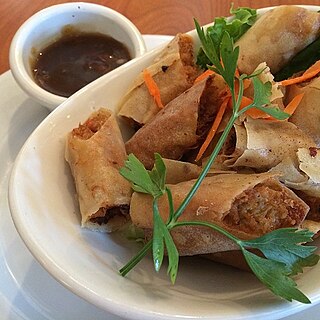
Lumpiang Shanghai is a Filipino deep-fried appetizer consisting of a mixture of giniling with vegetables like carrots, chopped scallions or red onions and garlic, wrapped in a thin egg crêpe. Lumpiang Shanghai is regarded as the most basic type of lumpia in Filipino cuisine, and it is usually smaller and thinner than other lumpia variants.
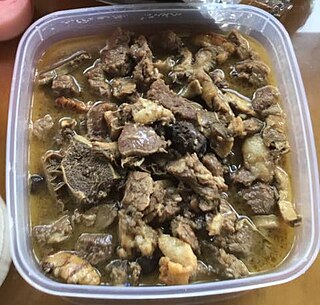
Pinapaitan or papaitan is a Filipino-Ilocano stew made with goat meat and offal and flavored with its bile, chyme, or cud. This papait gives the stew its signature bitter flavor profile or "pait", a flavor profile commonly associated with Ilocano cuisine. Similar to other Ilocano meat dishes, pinapaitan does not contain any vegetables other than those used for flavoring.
